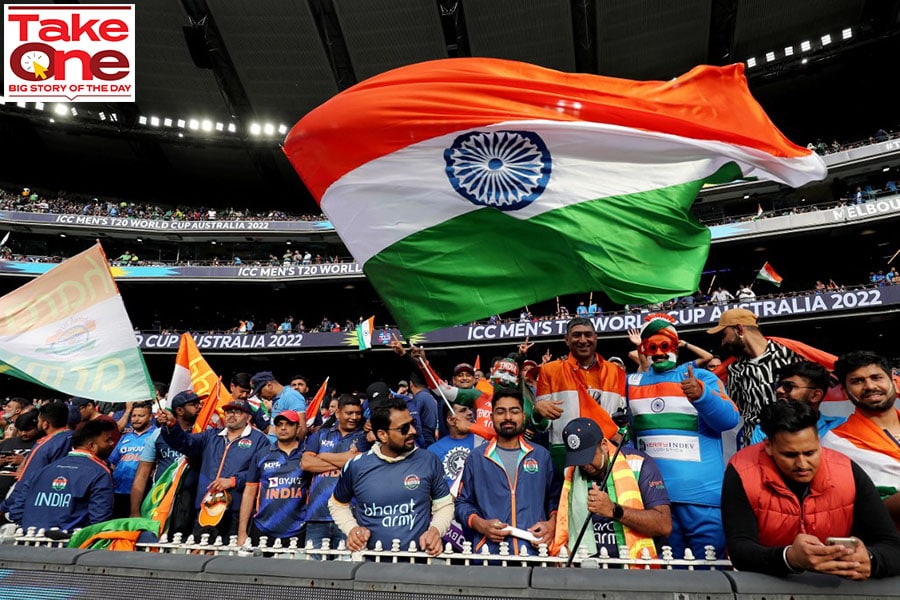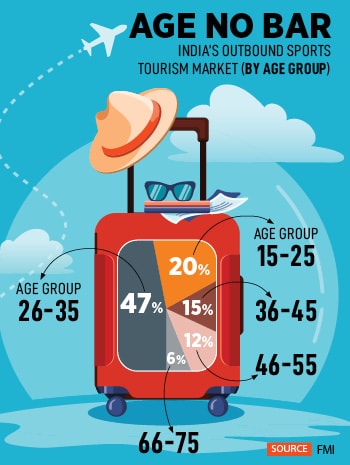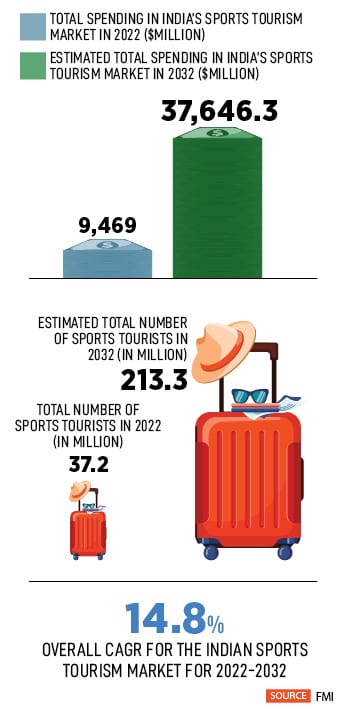
Fun and Games: How sports tourism is picking up pace in India
As nearly 20,000 fans travel to Australia for the T20 World Cup, and many more line up for the FIFA World Cup beginning this month, sports becomes the first segment within tourism to shake off the Covid-induced stasis
 Indian fans cheer during the ICC men's Twenty20 World Cup 2022 match between India and Pakistan at Melbourne Cricket Ground in Melbourne on October 23, 2022.
Photo:
Surjeet Yadav / AFP
Indian fans cheer during the ICC men's Twenty20 World Cup 2022 match between India and Pakistan at Melbourne Cricket Ground in Melbourne on October 23, 2022.
Photo:
Surjeet Yadav / AFP
Among the thousands bringing the roof down in Adelaide, where India takes on England in the semifinal of the T20 World Cup, will be Rakesh Patel and his army of travelling fans, who are tailing Team India with flags, dholaks and their indefatigable vocal chords. It’s a journey Patel has been on since the 1999 ODI World Cup in England—when he bumped into three kindred souls and decided to get together during the India-Pakistan tie to amp up the decibels at Old Trafford, where the high-octane match was being held. Once the tournament wrapped up, Patel launched the Bharat Army, which would gather for every India match to drum up support from the stands.
In 2015, the Bharat Army snowballed into a group of 500 that travelled to Australia for the ODI World Cup. “Back then, we had no commercial interests in mind. But during this trip, we had to manage tickets, stays, excursions for this large group,” says Patel, now a resident of London. “When I returned, I thought we had an opportunity to build something from this.” That’s when the 47-year-old launched the Bharat Army Travel & Tours, a sports tourism and hospitality vertical that curates travel packages themed on sporting experiences.
In 2017, it became an International Cricket Council (ICC)-accredited agency and gathered around 1,200 Indian cricket fans from around the world to showcase the Champion’s Trophy in England. “In 2019, for the ODI World Cup, the number jumped to 11,500-odd,” says Patel. It's a number he is looking to repeat for next year's ODI World Cup to be held in India. “A lot of Indians abroad are saving up for the tournament to be held in India, the game’s spiritual home, and I am expecting to bring in a 10,000+ contingent,” he says.




 “There are a lot of investments being done in the sports culture in the country. There’s an ecosystem of sports marketing, a lot of startups have come up, plus there is a government thrust on sports as events like Khelo India and the National Games are being broadcast,” says Neeraj Singh Dev, senior vice president-ecommerce India and shorthaul holidays, Thomas Cook India. “All these factors will ensure sports tourism will grow at a brisk pace.”
“There are a lot of investments being done in the sports culture in the country. There’s an ecosystem of sports marketing, a lot of startups have come up, plus there is a government thrust on sports as events like Khelo India and the National Games are being broadcast,” says Neeraj Singh Dev, senior vice president-ecommerce India and shorthaul holidays, Thomas Cook India. “All these factors will ensure sports tourism will grow at a brisk pace.” 
 With sports tourism exploding as a market, a number of official tour operators are adding money-can’t-buy experiences to packages to lure the discerning customer. How about a seat in front of the Indian dressing room at the SCG, a yacht party with Brett Lee or a photo-op with a Barca great during a visit to Camp Nou? Travel companies are throwing it all in. “The charm of going with these operators is the events. A day before the 2019 World Cup final, one of the companies organised a meet-and-greet with cricket greats Clive Lloyd, Sunil Gavaskar and Michael Clarke at The Oval. Imagine what it can do to a fan,” says Rishee Chhabra, an inveterate traveller and founder of Pitch Memorabilia, a collection of exclusive autographed cricket merchandise.
With sports tourism exploding as a market, a number of official tour operators are adding money-can’t-buy experiences to packages to lure the discerning customer. How about a seat in front of the Indian dressing room at the SCG, a yacht party with Brett Lee or a photo-op with a Barca great during a visit to Camp Nou? Travel companies are throwing it all in. “The charm of going with these operators is the events. A day before the 2019 World Cup final, one of the companies organised a meet-and-greet with cricket greats Clive Lloyd, Sunil Gavaskar and Michael Clarke at The Oval. Imagine what it can do to a fan,” says Rishee Chhabra, an inveterate traveller and founder of Pitch Memorabilia, a collection of exclusive autographed cricket merchandise. 






